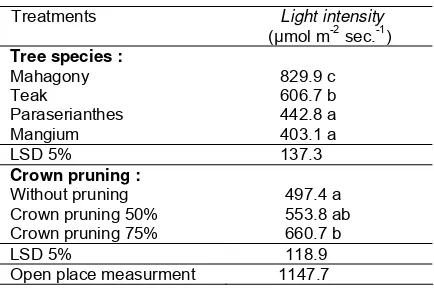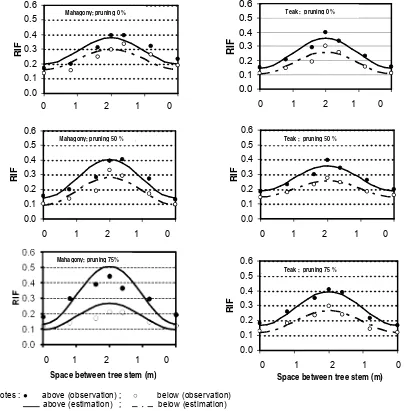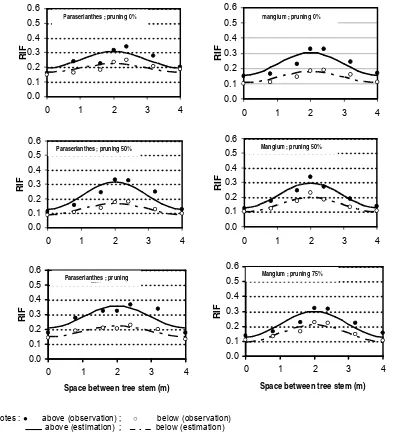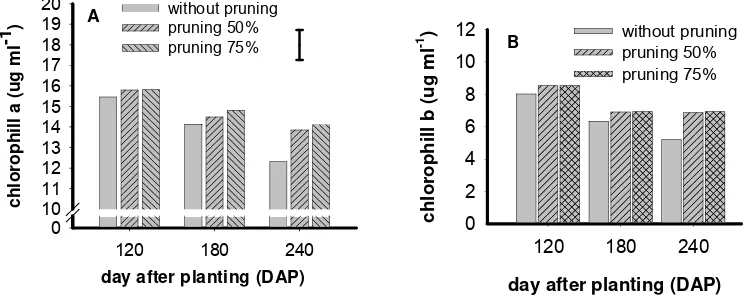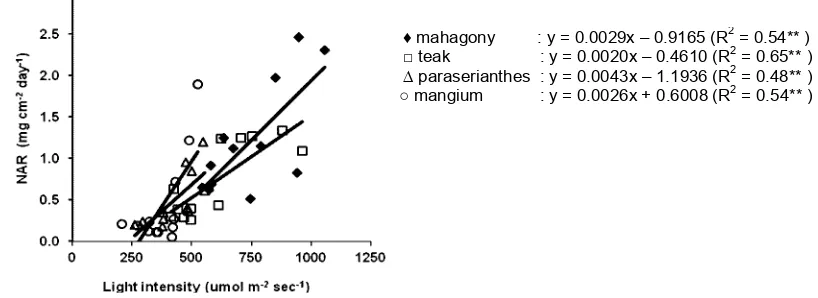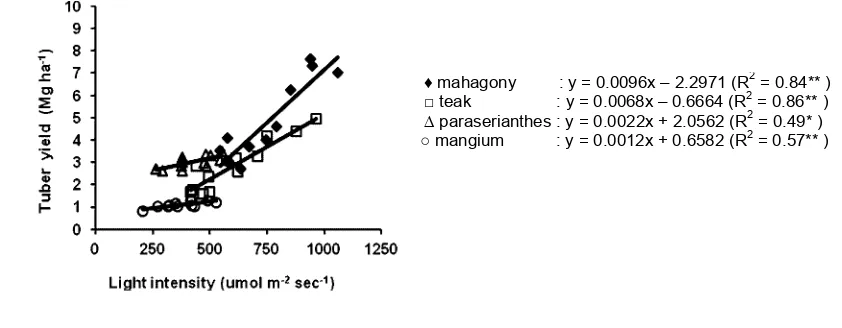GROWTH AND YIELD OF CASSAVA IN AGRO FORESTRY SYSTEM USING CROWN
TREE MANAGEMENT: CROWN PRUNING FOR OPTIMIZATION LIGHT INTERCEPTION
Mofit Saptono*)and Hastin Ernawati N.C.C.
Program Study of Agrotechnology Faculty of Agriculture University of Palangka Raya Jl. Yos Sudarso Palangka Raya 73112, Central Kalimantan Indonesia *)
Corresponding author Phone: +62-536-3222664 E-mail : [email protected]
Received : December 5,2008/ Accepted : April 29, 2010
ABSTRACT
The aim of this research is to measure the light intensity change under the tree due to the change of crown tree density in agro forestry system. The factorial completely randomized block design with four replications was applied on this research. The first factor were species in agro forestry system namely: mahagony (Switenia mahagony), teak (Tectona grandis), para-serianthes (Paraserianthes falcataria) and mangium (Acacia mangium). The age of the species mentioned above is five years old. Second factor were crown tree pruning including; without pruning (0%), pruning 50%, and pruning 75%. The result showed that the light intensity in open area is 1150 µmole m-2 sec-1.The average of light intensity under the crown tree of mahagoni, teak, paraserianthes and mangium were 830, 607, 443 and 403 µmole m-2sec.-1, respectively. The light intensity under the tree without pruning was 497 µmole m-2 sec-1, whereas with 50% and 75% of pruning increased light intensity up to 554 and 661 µmole m-2 sec.-1, respectively. Cassava tuber yield in agro forestry system were 5.4; 3.2; 3.7 and 1.2 Mg ha-1 respectively under mahagony, teak, paraserianthes and mangium, respectively. The yield of cassava in agro forestry system was lower than monoculture system (26.9 Mg ha-1).
Keywords: crown tree, mahagony, teak, para-serianthes, mangium, cassava, agro-forestry system
INTRODUCTION
Light competition in agro forestry system is a process which can immediately be seen its influence at crop which grow under trees. Tree crown in agro forestry system can hinder the sunlight needed by crop. Light intensity and the tree crown density will decrease simultaneously.
The fast growth tree type with many branches has higher crown density than the slow growth tree type.
Light is the main source of energy for photosynthesis. Insufficiency of light will cause crop metabolism, the change of transformation, and crop structure disorder (Sundari et al., 2005). Therefore, a crown trees management is needed in agroforestry system for a crop to obtain light. Huxley (1999) suggested that crown trees management can reduce the light competition occurring between tree and crop.
Crown trees is a component which reduces light quality and quantity accepted by crop (Schroth et al., 2001). Width, thickness, and density of crown trees will lessen the light to land surface (change terminology) (Suryanto et al., 2005). Therefore, to lessen the light competition in agro forestry system, crown trees pruning can be carried out (Suprayogo et al., 2003). Crown trees pruning is an action to decrease crown dense by cutting branch or stick. Crown trees pruning is intended to increase light interception. Increasing of light interception will give the opportunity to crop (under tree) to get more light.
Rate of photosynthesis cassava is 15-35 µmole of CO2 m
-2
sec-1 in temperature 30 0C (Ekanayake, 1997). Cassava has the mechanism of photosynthesis of C3 type, According to Otto (1998), the temperature change in the photosynthesis mechanism show that C3 type has higher photosynthesis compare to C4.
Crop with the mechanism of photo-synthesis of C3 type has lower light saturation compared to C4 crops (Larcher, 1995). Crop with the C3 type has the opportunity to be cultivated in low light intensity condition like in agro forestry system.
increase the light intensity 70% and 80%, density in agro forestry system.
MATERIALS AND METHODS
Research was conducted at Negara Jaya Village, Negeri Besar, North Lampung (Sumatera) since from February to October 2003. The research was carried out in agro forestry system mahagony+cassava, teak+cassava, para-serianthes+cassava and mangium+cassava.
Randomized complete block design was used with four replications. First factors were trees species in agroforestry system, namely : mahagony, teak, paraseriathes and mangium. Second factors were crown trees pruning, including: without pruning (0%), 50% pruning and 75% pruning.
The age of tree observed for this research was a five-year-old tree. Cassava used in this research is Adira 4 clone.
Cassava is planted between trees. The tree plant spacing was 2.0 x 4.0 m, while cassava plant spacing was 1.0 x 0.5 m. Fertilization for cassava is done by using urea (215 kg ha-1), SP 36 (167 kg ha-1) and KCl (100 kg ha-1).
A half urea, the whole SP 36 and KCI fertilizer were given to plants. A half more of urea was given 30 days after cassava (DAP) was planted with the same procedure.
Light intensity which gets away under crown tree was measured by using lightmeter/sunfleck ceptometer (Decagon SF-80 ; Delta-T Devices Ltd ; 1989). Measurement of intensity under crown tree was assessed with the relatives irradiance fraction (RIF) (Febrianto, 2004 and Purnomo, 2004).
RESULTS AND DISCUSSION
The average of light intensity in an open place is 1149,75 µmole m-2 sec-1. Research result showed that crown pruning 50% and 75% increased light intensity under tree up to both 10 and 25%. Mahagony and teak with the slow growth branch have the low crown density. Paraserianthes and mangium have more density of crown. Mahagony (Switenia mahagony), teak (Tectona grandis), paraserianthes ( Paraserian-thes falcataria) and mangium (Acacia mangium) in agro forestry system reduce the light intensity were 28, 47, 62 and 65%, respectively (Table 1).
Relatives irradiation fraction (RIF) values will increase with progressively if the distance is far from tree. Under mahagony, teak, para-serianthes and mangium ; relatives irradiation fraction at distance 1.5-2.0 m from tree showed the highest value (Figure 1 and 2). The 50 % and 75% crown pruning increased RIF at 10 and 15% (above crown cassava) and 8 and 12% (under crown cassava) respectively.
Table 1. Light intensity under the tree influenced by tree’s species and crown pruning
Treatments Light intensity
Crown pruning 50% 553.8 ab
Crown pruning 75% 660.7 b
LSD 5% 118.9
Open place measurment 1147.7
Notes : ● above (observation) ; ○ below (observation) above (estimation) ; below (estimation)
Figure 1. RIF value under mahagony and teak without pruning, 50% pruning and 75% pruning treatments mahoni ; tanpa pangkas
0.0 0.1 0.2 0.3 0.4 0.5 0.6
0 1 2 3 4
R
IF
0 1 2 1 0
0 1 2 1 0 mahoni ; pangkas 50%
0.0 0.1 0.2 0.3 0.4 0.5 0.6
0 1 2 3 4
R
IF
jati ; pangkas 50%
0.0 0.1 0.2 0.3 0.4 0.5 0.6
0 1 2 3 4
R
IF
jati ; pangkas 75%
0.0 0.1 0.2 0.3 0.4 0.5 0.6
0 1 2 3 4
Jarak antar barisan pohon (m)
R
IF
0 1 2 1 0 0 1 2 1 0 0 1 2 1 0
jati ; tanpa pangkas
0.0 0.1 0.2 0.3 0.4 0.5 0.6
0 1 2 3 4
R
IF
0 1 2 1 0
Space between tree stem (m)
Mahagony; pruning 75% Mahagony; pruning 50 %
Mahagony; pruning 0 % Teak ; pruning 0 %
Teak ; pruning 50 %
Teak ; pruning 75 %
Notes : ● above (observation) ; ○ below (observation) above (estimation) ; below (estimation)
Figure 2. RIF value under paraserianthes and mangium without pruning, 50% pruning and 75% pruning treatments
The average of cassava plant height in monoculture (210 DAP) was 164 cm. Decreasing of light intensity under mahagony teak and para-serianthes were 27, 47, 62 and 67%, respectively led to higher cassava were 10, 15, 16 and 6% compared to monoculture (Tables 2). Light intensity under mangium was decreased more
than under mahagony, teak and paraserianthes. Decreasing light intensity under the tree until 65% caused abnormal cassava growth.
Shaded crops have wider leaf area and it represents one of mechanisms of crop adaptation to low light intensity. Leaf area of cassava monoculture at 180 DAP was 5740 cm2. Reduction sengon ; tanpa pangkas
Jarak antar barisan pohon (m)
R
Jarak antar barisan pohon (m)
R
in light intensity caused by the shade of paraserianthes crown caused cassava leaf area 23% wider than in the monoculture. Under mangium, cassava was not able to grow optimally, then the leaves of these plants grew abnormally.
Decreasing of light intensity under mangium influenced cassava specific leaf area (SLA). Low light intensity under crown increased interception ability by increasing leaf area but not in leaf weight. This condition causes the leaves of cassava become thinner as indicated by the higher value of specific leaf area (SLA). This showed that the reduction in light intensity up to 65% under the tree gave the significant influence on SLA (Table 2).
The higher leaf area index (LAI) values consequences of competition among the leaves on these plants. Under mahagony, teak and paraserianthes, cassava leaves are suspected to be overshadowed. It is represented by leaf area content of cassava leaves under mahagony, teak, paraserianthes and mangium tends to decrease while the cassava age increases (Figure 3). Cassava chlorophyl content under paraserianthes and mangium was low due to the low light intensity. This matter caused the change of protoplastida to chloroplast. At this condition, more protoplastida turned into etioplast (Salisbury and Ross, 1995).
Light intensity under paraserainthes and mangium reduces to 62 and 65% (Table 1). Leaf as an apparatus of photosynthesis has also undergone a physical change under the tree. Cassava leaves become wider and thiner, as shown by the higher value of SLA (Table 2.) Content of chlorophyll a and b of cassava under paraserianthes and mangium is lower and declines to 240 DAP. Such a condition leads to the ability reduction of photosynthesis process of cassava.
Relative growth rate (RGR) and net assimilation rate (NAR) of cassava increase until the age of 150-180 DAP, and then it decreases after those ages. This condition is related to Gardner et. al. (1991) where the value of RGR and NAR is not constant to time, but it decreases with increasing age of the plant. The decrease of light intensity becomes a limiting factor of plant assimilation.
Adaptation ability to the shade can occur by changing the morphological or physiological characteristics i.e. higher plants and wider leaf surface. The decrease of light intensity under paraserianthes and mangium caused the change of cassava morphology and physiology which affected the photosynthesis process. This condition caused cassava RGR and NAR under paraserianthes and mangium lower than that under mahagony and teak.
Crown pruning 50% and 75% causes an increase of light intensity to 10% and 25%. This condition causes cassava RGR and NAR under trees with crown pruning higher than that under tree without pruning (Figure 4).
Cassava cultivation under each tree’s species gave different yield (Mg ha-1). Tuber yield showed the ability of cassava photosynthesis result which was translocated to sink storage (root). Under tree with crown pruning 50 and 75%, tuber average obtained only 3.4 and 4.2 Mg ha-1 (Table 2).
Research results showed that there was variability occurred in agro forestry systems in cassava. Ekanayake et al.(1997) research showed that the cassava has a rapid vegetative growth at age 4 to 5 months. After that, the growth will decrease because of tuber formation phase. Differences of tree growth rate influenced the growth of cassava. Crown shade is the influential factor for cassava growth After crown pruning, paraserianthes and mangium grew more quickly than mahagony and teak. Therefore, cassava under paraserianthes and mangium received less light than cassava under mahagony and teak.
Result observation showed cassava under mangium without crown pruning grew slower and the light intensity under this tree was very low (Table 1). Gwathmey and Howard (1998) suggested that canopy architecture influenced the growth in two things, first; distribution and light intensity; second; the crop growth and development.
physiological response by increasing leaf area (Lambers et al., 2000).
Cassava under mahagony and teak with crown pruning 50% and 75% accepted the longer and more light compared to cassava under pareserianthes and mangium by same crown pruning. This condition was supported with the fact that cassava leaf under mahagony and teak had the higher leaf area index (LAI) compared to cassava leaf under paraserianthes and mangium.
Tree influenced the crop growth under tree through change light interception, nutrients, and ground water (Scholes and Walker, 1993 in Suryanto et al., 2005). Research result showed that the tree crown pruning caused an open crown which led to increased cassava RGR.
Under mahagony and teak, the value of cassava RGR was higher because of more light received. Figure 5 showed linier relationship between cassava growth rate and light intensity under mahagony, teak, paraserianthes and mangium. Increased cassava growth rate under teak and mahagony caused by increased light
intensity was greater than that of under paraserianthes and mangium.
Cassava under paraserianthes and mangium got the light intensity of 443 and 402 µmole m-2 sec-1, respectively. It was still not able yet to increase growth rate that was equivalent to the growth rate of cassava under mahagony and teak. However, 75% crown pruning provided better effect compared to no pruning and 50% pruning.
Net assimilation rate (NAR) can be used to evaluate leaf efficiency in photosynthesis (Usuda and Shimogawara, 1998; Hall and Rao, 1999), This was related to the ability of crop performance on photosynthesis process.
Pigment analysis result of leaf cassava under mahagony showed the chlorophyll a content was 13.6 µg ml-1 and chlorophyll b content was 6.3 µg ml-1. Result showed the light intensity under mahagony was 830 µmole m-2 sec-1. Chlorophyll a, chlorophyll b and light intensity were able to produce cassava higher net assimilation rate than crop under teak, para-serianthes and mangium.
Table 2. Average plant height (210 DAP), leaf area, leaf area index, specific leaf area (180 DAP) and yield of cassava influenced by tree’s species and crown prunings
Treatments Plant height Leaf area Leaf area Specific leaf Yield
(cm) (cm2) index area (cm2 g-1) (Mg ha-1)
Tree species :
Mahagony 191.9 5215.5 1.1 527.0 c 5.42 c
Teak 183.2 5175.8 1.0 456.9 a 3.74 b
Paraserianthes 194.4 7488.5 1.0 653.9 b 3.24 ab
Mangium 174.1 4688.6 0.9 473.8 a 1.12 a
LSD 5% tn tn tn 88.1 1.04
Crown pruning :
Without pruning 168.2 a 6942.7 c 0.7 a 539.1 2.62
Crown pruning 50% 188.6 ab 5680.5 b 1.3 b 543.2 3.38
Crown pruning 75% 200.7 b 4303.1 a 1.4 b 501.6 4.17
LSD 5% 27.9 520.5 0.2 ns ns
Notes : bar represent standard error of difference (SED)
Figure 3. Content of a and b chlorophylls of cassava (at 120, 180 and 240 DAP) were influenced by tree crown pruning.
Notes : bar represent standard error of difference (SED)
Figure 4. Crop growth rate and net assimilation rate of cassava influenced by tree crown pruning at 120, 150-180 and 180-210 DAP
Figure 6 showed relationship between cassava net assimilation rate with the light intensity under mahagony, teak, paraserianthes and mangium. Cassava that gets more light intensity, net assimilation rate will have a better value. Crown pruning allegedly provided a better environment for cassava to perform photo-synthesis process. Pigment analysis showed that cassava chlorophyll a and b content under tree with 50% and 75% crown pruning had higher
value, thus, cassava under the tree showed better growth.
Crop yield represents the accumulation of dry weight within a certain time. How efficient crop utilizes the radiation and how long this crop can sustain such use will determine crop harvest. Figure 7 shows the pattern of relationship between tuber yield with light intensity under mahagony, teak, paraserianthes and mangium, and this pattern is similar. However, increasing light A s/d 120 120-150 150-180 180-210
N s/d 120 120-150 150-180 180-210
intensity under mahagony and teak can increase tuber yield more than that under paraserianthes and mangium.
The average of light intensity under mahagony, paraserianthes and mangium reached 830 and 607 µmole m-2 sec-1, respectively and it produced 5.4 Mg ha-1 and 3.7 Mg ha-1 tuber yield respectively. Under para-serianthes and mangium, light intensity average was 443 and 403 µmole m-2 sec-1 respectively. Tuber yield average was 3.2 Mg ha-1 and 1.2 Mg ha-1 respectively. Although tuber yield obtained under mahagony and teak was higher while this yield was lower compared to the monoculture, which was 26.9 Mg ha-1.
Meanwhile, the average of tuber yield of cassava clone Adira 4 which can reach 35-45 Mg ha-1 (Sitompul et al., 1992 ; Sundari et al., 2002). Light intensity on 50 and 75% crown pruning treatment increases cassava tuber yield.
Cassava yield was also related to its ability to photosynthesize. Cassava which has more chlorophyll content and more net assimilation rate has potency to produce more tuber yield. It can be seen from cassava planted under mahagony and teak with 50% and 75% crown pruning.
Figure 5. Relationship between cassava growth rate and light intensity under mahagony, teak, paraserianthes and mangium
Figure 6. Relationship between cassava net assimilation rate and light intensity under mahagony and teak, paraserianthes and mangium
♦ mahagony : y = 0.0311x – 10.188 (R2
= 0.67** ) □ teak : y = 0.0073x – 0.3362 (R2 = 0.40** ) ∆ paraserianthes : y = 0.0079x - 0,2526=.2526 (R2
= 0.48** ) ○ mangium : y = 0.0033x + 0.5523 (R2 = 0.57** )
♦ mahagony : y = 0.0029x – 0.9165 (R2 = 0.54** ) □ teak : y = 0.0020x – 0.4610 (R2 = 0.65** ) ∆ paraserianthes : y = 0.0043x – 1.1936 (R2
Figure 7. Relationship between yield of cassava and light intensity under mahagony, teak, paraserianthes and mangium
CONCLUSIONS AND SUGGESTION
RIF optimum of mahagony, teak, para-serianthes and mangium is at 1.5-2.0 m distance from stem tree. The highest RIF value in this observation was obtained under mahagony with 75% crown pruning, that is 0.42. The lowest RIF value was obtained under mangium without crown pruning, that is 0.29. Crown pruning 50 and 75 % is able to increase RIF value under mahagony, teak, paraserianthes and mangium.
Paraserianthes and mangium is the fast branch growth tree causing longer time of shading toward cassava. Meanwhile, mahagony and teak, slow branch growth tree, provide opportunity to cassava to capture light longer. The treatment of 50 % and 75% crown pruning increases the light intensity under trees about 10% and 25% respectively, and increases the cassava RGR and NAR as well. Cassava NAR under mahagony and teak is 0.8 and 0.7 mg cm-2 day-1 , producing tuber yield 5.4 and 3.2 Mg ha-1. Tuber yield under paraserianthes and mangium is 3.7 and 1.2 Mg ha-1 with the NAR value 0.4 and 0.3 mg cm-2 day-1. This result is still lower compared to cassava monoculture yield, that is equal to 26.9 Mg ha-1.
ACKNOWLEDGEMENTS
Thanks to Smallholder Agroforestry Option for Degraded Soils (SAFODS) Project of Brawijaya University (UB), International Center For Research in Agroforestry (ICRAF) South East
Asia, what have given the opportunity and facility in research. Thanks also to Mr. Prof. Bambang Guritno, Mrs. Prof. Kurniatun Hairiah and Mr. Didik Suprayogo, Ph.D., for tuition during study and research in Postgraduate Agriculture Faculty, Brawijaya University (UB), Malang, East Java, Indonesia.
REFERENCES
Enkayake, I.J., D.S.O. Osiru and M.C.M Porto, 1997. Morphology of cassava. IITA Research Guide No. 61.
Febrianto, T. 2004. Potency asumption maize yield the planted between teak in agro-forestry system at Lodoyo, Blitar. Thesis. Agriculture Faculty, Brawijaya University UB, 16p.
Gardner, F.P., R.B. Pearce and R.G. Mitchell, 1991. Physiology of crop plants. The Iowa State University Press
Gwathmey, C.O. and D.D. Howard. 1998. Potassium effects on canopy light inter-ception and earliness of no-tillage cotton. Agronomy Journal 90: 144-149.
Hall, D. O. and K. K. Rao. 1999. Photosynthesis : studies and biology (9th edtion), Cambridge University Press. pp.214. Huxley, P.1999. Tropical agroforestri. Black-well
Science Ltd. Oxford. London. pp. 371. Lambers, H., F.S. Chapin and T.L. Pons. 2000.
Plant physiological ecology. Springer-Verlag New York Inc. pp.540.
♦ mahagony : y = 0.0096x – 2.2971 (R2
= 0.84** ) □ teak : y = 0.0068x – 0.6664 (R2 = 0.86** ) ∆ paraserianthes : y = 0.0022x + 2.0562 (R2
Larcher, W. 1995. Physiological plant ecology (3rd edition). Springer, Germany. pp. 506. Otto, J.A., 1998. Rapid multiplication of cassava.
IITA Research Guide No. 51.
Purnomo, Dj., 2004. The increase of agronomy function of agroforestry system of teak and pines with maize and soybean based on radiation energy reference. Disertation. Postgraduate of Brawijaya University (UB) Malang. pp.198.
Salisbury, F. B. and C. W. Ross. 1995. Plant physiology (4th edition). Wadsworth Publ. Co. Diah R. Lukman dan Sumaryono (translate). ITB Press. Bandung. Indo-nesia. pp.241.
Schroth, G., J. Lehmann, M.R.L. Rodrigues, E. Barros and J.L.V. Macedo, 2001. Plant-soil interactions in multistrata agro-forestry in the humid tropics. Agro-forestry ystems 53: 85-102.
Sitompul, S.M., S. Setijono, J. van der Heide, M. van Noordwijk. 1992. Crop yield an sus-tainability of cassava-based system on an ultisols in Lampung. Agrivita 15(1): 19-28
Suprayogo, D., K. Hairiah, N. Wijayanto, Sunaryo and M. van Noordwijk, 2003. Agro-forestri role in the plot scale: Component analysis of agroforestri as key of efficacy or failure of exploiting farm. World Agroforestry Centre (ICRAF). Bogor, Indonesia. pp.46.
Sundari, T., Koes Hartojo and W. Unjoyo. 2002. Potency and yield of cassava expectation clones in alfisol and ultisol. Page 184-191 in A. Winarto, B.S. Koentjoro dan T. Fitriyanto (editors). The increase of pro-ductivity, quality, efficiency and produce system of legume and tuber plants to the resilience of food and agribusiness development. Center Research of Legumes and Tuber Plants. Malang. Indonesia. pp.129.
Sundari, T. Soemartono, Tohari and W. Ma-ngoendidjojo, 2005. Yield variability and genotipe tolerance of green peanut to shade. Agriculture Science J. 12(1): 12-19.
Suryanto, P., Tohari, M.S. Sabarnurdin, 2005. Dinamics of resources sharing system in agroforestry : Based of compilation con-sideration Silviculture Strategy. Agri-culture Science J. 2(12): 165-178 Usuda, H. and K. Shimogawara. 1998. The effect
